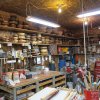Mark Hepburn
Artist & Chef
Okay, so I have a nice upright freezer that was free. No refrigerant remaining but the works are still in it (and those I'm going to remove). I plan on making a drying kiln of it and have been reading tons of material on the web at various forums, blogs and DIY sites. The debate rages on and I thought, why not start a debate right here regarding same? 
So I'm asking, what is the optimal way to convert this thing, which will reside in a conditioned space in a room adjacent to my shop? I have some spare lamps, lots of large drill bits and so on. What I lack is knowledge on a variety of topics.
My first impulse is to put a bunch of holes in the sides at top and bottom, stick in a 60W incandescent, and let convection do its work. On the other hand, there's a part of me that wants to front mount a hygrometer with a probe, put a louvered door somewhere in it with a PC fan and a humidistat and so on. But really, you engineering types here are the ones with the skill set for this not me. I'm basically a glorified chef (ex- at that).
So having said all that, can a brother get a hand here?
<soapbox>
And please, don't say something like, " well you need a 12.v stepper drive with boolean logic and a 3 phase capacitating-inductor whoosit with a DRAM/RAMDAC vapor proximity sensor... "
What I'm saying is, dumb it down a bit. I can wire a ceiling fan and replace GFCIs without getting electrocuted. And it's been almost 50 years since I built that last Heathkit radio.
</end soapbox>
Anyway, in all seriousness, I'd appreciate some help. I was thinking about putting a dehumidifier in it with the collection hose poking out, and putting in a small fan. As to the hygrometer, I did find one on Amazon for about 20 bucks that has good reviews and a probe. So I can put it in the freezer and glue the display on the door.
But there are so many questions about how to optimize this, such as fan, yes or no and what type and how much air movement do I need? Lights, how many and so on.
So thanks to any of you who took the time to read this.

So I'm asking, what is the optimal way to convert this thing, which will reside in a conditioned space in a room adjacent to my shop? I have some spare lamps, lots of large drill bits and so on. What I lack is knowledge on a variety of topics.
My first impulse is to put a bunch of holes in the sides at top and bottom, stick in a 60W incandescent, and let convection do its work. On the other hand, there's a part of me that wants to front mount a hygrometer with a probe, put a louvered door somewhere in it with a PC fan and a humidistat and so on. But really, you engineering types here are the ones with the skill set for this not me. I'm basically a glorified chef (ex- at that).
So having said all that, can a brother get a hand here?
<soapbox>
And please, don't say something like, " well you need a 12.v stepper drive with boolean logic and a 3 phase capacitating-inductor whoosit with a DRAM/RAMDAC vapor proximity sensor... "
What I'm saying is, dumb it down a bit. I can wire a ceiling fan and replace GFCIs without getting electrocuted. And it's been almost 50 years since I built that last Heathkit radio.
</end soapbox>
Anyway, in all seriousness, I'd appreciate some help. I was thinking about putting a dehumidifier in it with the collection hose poking out, and putting in a small fan. As to the hygrometer, I did find one on Amazon for about 20 bucks that has good reviews and a probe. So I can put it in the freezer and glue the display on the door.
But there are so many questions about how to optimize this, such as fan, yes or no and what type and how much air movement do I need? Lights, how many and so on.
So thanks to any of you who took the time to read this.






